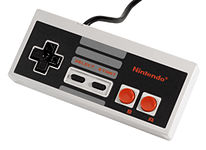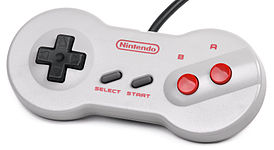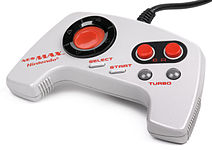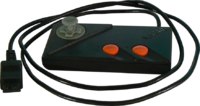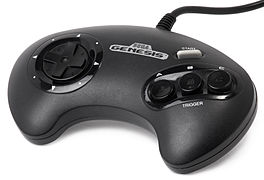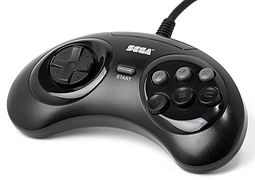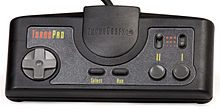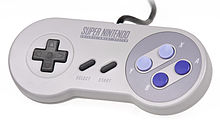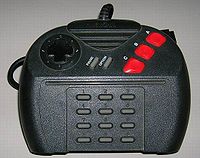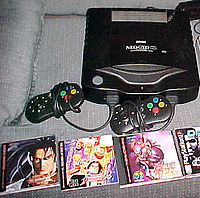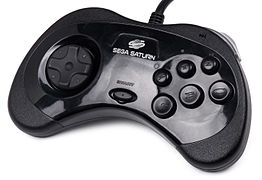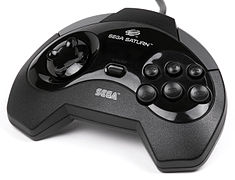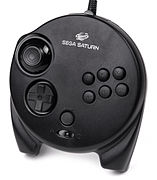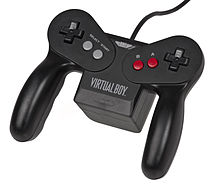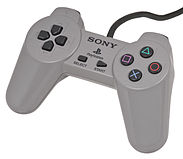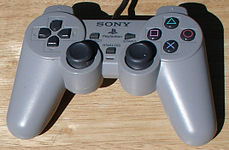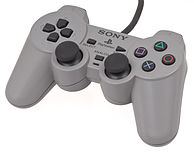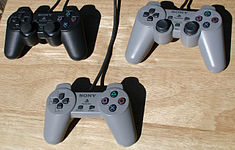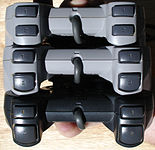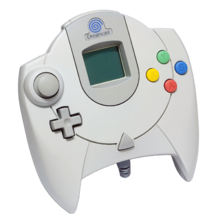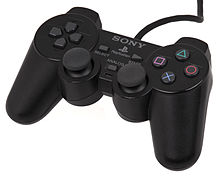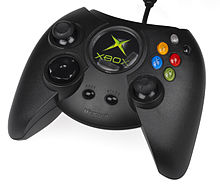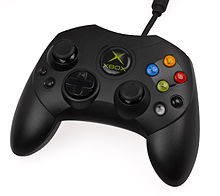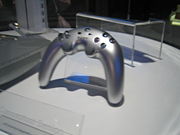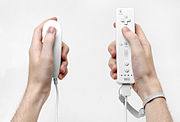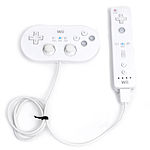- Gamepad
-
For the TV show, see Gamepad (TV series).
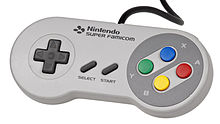 The SNES/Super Famicom gamepad (Japanese Super Famicom version shown), which popularized the layout used by most modern gamepads
The SNES/Super Famicom gamepad (Japanese Super Famicom version shown), which popularized the layout used by most modern gamepads
A gamepad (also called joypad or control pad), is a type of game controller held in two hands, where the digits (especially thumbs) are used to provide input. Gamepads generally feature a set of action buttons handled with the right thumb and a direction controller handled with the left. The direction controller has traditionally been a four-way digital cross (also named a joypad, or alternatively a D-pad), but most modern controllers additionally (or as a substitute) feature an analog stick.
Some common additions to the standard pad include shoulder buttons placed along the edges of the pad, centrally placed start, select, and mode buttons, and an internal motor to provide force feedback.
Gamepads are the primary means of input on all modern video game consoles except for the Wii (though the Wii Remote can function alternately as a gamepad). Gamepads are also available for personal computers.
There are programmable joysticks that can emulate keyboard input. Generally they have been made to circumvent the lack of joystick support in some computer games, i.e. the Belkin Nostromo SpeedPad n52. There are several programs that emulate keyboard and mouse input with a gamepad such as JoyToKey, Xpadder, and Pinnacle Game Profiler.
Some manufacturers and retailers may also use the term "gamepad" to refer to a gaming keypad.
Contents
Third Generation
The third generation of video games saw many major changes, and the eminence of gamepads in the video game market. Nintendo launched the NES controller, and was followed soon later by Sega's Master System controller in 1986. Gamepads offered gamers a new and more universal way to play games, and their dominance continued throughout later generations as they eventually became the only significant kind of game controller.
Nintendo Entertainment System/Family Computer
The NES (known as the Family Computer, or "Famicom" in most of Asia) controller used Nintendo's patented cross-shaped joypad (a modified version of Milton Bradley's Cosmic Hunter joypad concept), which was used by their "Game & Watch" series of games as the standard for their home console controllers. The NES and Famicom controllers both featured a brick-like design with a simple, four button layout: two action buttons labeled "A" and "B", a "start" button and a "select" button. Near the end of the NES's lifespan, upon the release of the AV Famicom and the NES 2, the design of the game controller was modified slightly, abandoning the "brick" shell in favor of a "dog bone" shape, reminiscent of the controllers of its successor the Super Nintendo Entertainment System/Super Famicom.
The original Famicom controllers were different from the NES ones in the sense that, besides their cosmetic design and being hardwired into the console, the second controller lacked Select and Start buttons. In their place was a microphone, although very few games supported it. Initially, Famicom controllers were manufactured with square-shaped A and B buttons, but these were discontinued and recalled in 1984 due to being prone to heavy wear.[1]
The Famicom was also the first home system to put the directional control on the left. While many arcade systems had the directional control joystick on the left of the buttons, most home systems of the era used joysticks designed for right-handed operation. The division has continued to this day, with computer joysticks typically being designed for use in the right hand with gamepads and arcade joysticks favoring the left hand.
Master System
The Master System has a similar brick-shaped appearance to the NES controller, but the d-pad (named the "D button") is square-shaped instead of cross-shaped, and there are no distinct "select" and "start" buttons. The two action buttons were labeled "1" and "2", with the "1" button doubling as a "Start" button. Master System games were pausable only by accessing a button on the console itself. Some early models of the pad featured a hole in the center of the joypad into which a small attachment could be screwed to make the pad function more like a joystick. A proper joystick was later released for the machine. Unlike the Nintendo machines of the time, the Sega machines used a common D-subminiature connector and standard protocol, enabling their pads to be used on different systems.
Atari 7800
In response to criticism over ergonomic issues in the Pro-Line controllers, Atari later released joypad controllers with European Atari 7800s, which were similar in style to controllers found on Nintendo and Sega systems.
Fourth Generation
Genesis/Mega Drive
The Sega Mega Drive/Genesis control pad has an eight-direction d-pad (referred to by Sega as the D Button, short for directional button), a start button and three action buttons. The three buttons were enough for early arcade ports such as Golden Axe but as fighting games evolved (specifically the release of fighting games such as Street Fighter II and Mortal Kombat which required more than three action buttons to play effectively), a six-button pad was released. Noticeably smaller, it features 3 more buttons placed over the original three (traditionally called the "Street Fighter" layout). Some games were not natively compatible with the new controller (such as John Madden Football and Olympic Gold) so a "mode" button was placed in the right shoulder position to allow compatibility with these titles.[2] In order to work with these games, this button had to be pressed during the console power-on sequence, until the SEGA logo appeared. Both versions of the Mega Drive/Genesis pad used a DE9 connection and were compatible with most Master System games, as well as other systems such as the Atari 2600.
TurboGrafx-16/PC-Engine
The TurboGrafx-16's controller was similar to Nintendo's NES controllers, in that it had a D-pad, Start and Select buttons, and two face buttons, labeled "I" & "II". The system was launched for Japan (where it is known as PC Engine), America and Europe (on a limited basis) from 1987 to 1993, and games were produced for it until 1999. A unique feature of the controller was the built in Turbo buttons, which had 3 settings for the I & II buttons.
Super Nintendo Entertainment System/Super Famicom
The Super Nintendo Entertainment System (SNES) controller had a more rounded dog-bone like design than that of the NES and added two more face buttons, "X" and "Y", arranging the four in a diamond formation. Another addition was the "L" and "R" shoulder buttons, which have been imitated by most controllers since. This gave the controller a total of 8 buttons. The inclusion of six active buttons was influenced by the popularity of the Street Fighter arcade series, which utilized six buttons.[3]
There is a slight variation in the North American version of the controller. In the original design (used by the Japanese Super Famicom and PAL SNES) the A, B, Y and X buttons are all convex-curved and each one has a distinct color (A was red, B was yellow, X was blue, and Y was green). For the North American market, the A and B buttons were colored purple and the Y and X buttons were lavender and concave-curved.
Fifth Generation
Apple Bandai Pipp!n
The Apple Bandai Pipp!n was a short-lived console designed by Apple Computer Inc. and produced by Bandai. Fewer than 100,000 were manufactured. Its controller, the AppleJack controller, featured four colored primary action buttons (labeled with a number of raised (button 1) or indented (other buttons) dots), two shoulder buttons, three secondary action buttons (labeled with shapes: square, circle & diamond) and a circular D-Pad. Unlike other gamepads of the era, it also featured a trackball in the center of the controller.
Atari Jaguar
The Atari Jaguar was the first and last Atari console to employ the modern gamepad (rather than the older Pro-Line controller) as the standard controller shipping with consoles. The gamepad featured an array of 12 buttons (considerably more than other gamepads) in order to suit the predicted needs of future games, however this was criticized by gamers as unnecessarily complex. Beside the array of 12, the controller also had three action buttons (A, B, and C), a Pause and an Option button, making the total number 17. The later-released Pro Controller featured an extra three buttons bringing the total to 20.[4]
Neo Geo CD
The SNK Neo Geo CD controller is similar in shape and size to Sega Genesis/Mega Drive and Saturn gamepads and features 6 digital buttons and a d-pad/thumbstick. In the center of the controller are two "Start" and "Select" buttons and in the right thumb position are four colored action buttons labeled "A", "B", "C" & "D", arranged in a diamond formation. Movement is controlled via an unusual d-pad/thumbstick hybrid, which is used similarly to modern analog sticks, but technologically is closer to an 8-way digital d-pad, POV-hat or arcade stick.[5]
Saturn
The Japanese Sega Saturn control pad was based on the Mega Drive (Genesis) 6-button controller and has a D-pad and nine buttons: six action buttons (A, B, C, X, Y & Z), a start button and two shoulder buttons. The original North American and European variant is bigger and shaped differently. This version features a different d-pad and different face and shoulder buttons. It was replaced by the Japanese controller in 1996/1997 with the introduction of the model 2 Saturn.
The 3D Control Pad (also known as the Multi Controller or NiGHTS Controller),[6] released in 1996, introduced an analog stick and analog triggers. It was included with the breakthrough game, NiGHTS into Dreams..., as well as being available separately for other games that supported analog control such as Manx TT, Daytona USA: Championship Circuit Edition, Space Harrier, After Burner and Sky Target.[6]
Sega has since re-released the Japanese version of the Sega Saturn gamepad as a USB version compatible with Windows, Mac OS X and PlayStation 3.[7][8]
The optional Sega Saturn analog controller that came packaged with some copies of Nights into Dreams... Virtual Boy
The Virtual Boy controller was a controller which utilized dual joypads similar to how analog sticks functioned in later "dual control" sixth-generation systems. The presence of two pads was an effort to control objects in a 3D environment (one pad controlling pitch and turning while the other controlling forward movement and strafing). This dual joypad attempt was largely unsuccessful as was the game console itself and the Virtual Boy was discontinued.
PlayStation
Main articles: PlayStation control pad, Dual Analog Controller, and DualShockSony's original controller featured a four direction D-pad, four action buttons (referred not by color or letter/number like most pads until then, but by four colored shapes -
 ,
,  ,
,  ,
,  ), four shoulder buttons (R1, R2, L1, and L2, standing for right and left) and start and select buttons. The basic design and layout was based on that of Nintendo's SNES controller, as the PlayStation was originally developed as a CD add-on for the SNES, before becoming a console in its own right. It was the default pad for the first year of the PlayStation, until the release of the Dual Analog. It is often cloned for PC gamepads.
), four shoulder buttons (R1, R2, L1, and L2, standing for right and left) and start and select buttons. The basic design and layout was based on that of Nintendo's SNES controller, as the PlayStation was originally developed as a CD add-on for the SNES, before becoming a console in its own right. It was the default pad for the first year of the PlayStation, until the release of the Dual Analog. It is often cloned for PC gamepads.First announced in a press release in late 1995, the Dual Analog was finally shown to the public at the PlayStation expo in November 1996. It was similar to the original PlayStation controller, with several key differences. The Dual Analog's handles were longer and more tapered, the "L2 and R2" buttons were altered slightly, the first Japanese revisions had rumble capability and there were twin concave analog thumbsticks placed in the lower center of the controller, below a tri-function "mode" button. Apparently due to lack of interest, later models of Japanese Dual Analog controllers had the rumble feature removed.
The next revision saw the introduction of Sony's DualShock. This device brought back rumble (hence the name), cosmetically changed the handles (to the same shape as the original controller), analog sticks and "L2 and R2" buttons, removed the third "mode" option and added "L3 and R3" buttons, which were incorporated into the sticks themselves (accessed by pushing down on the stick). The controller was released as a secondary peripheral in late 1997 in Japan, and in May 1998 in North America. Its popularity dictated the end of the Dual Analog, and the DualShock was selected as the new standard controller during a large part of the console's life.
The Dual Analog Controller, the predecessor of the DualShock The upgraded PlayStation DualShock controller Nintendo 64
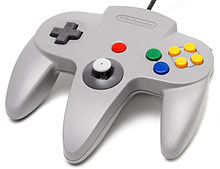 Nintendo 64 controller.
Nintendo 64 controller. Main article: Nintendo 64 controller
Main article: Nintendo 64 controllerNintendo 64's controller started a trend to have both an analog stick (referred to by Nintendo as a 'Control Stick') and a D-pad. It has the traditional A, B, L, and R buttons, along with a Z trigger button on its underside. Four "C" buttons were originally intended to control the camera in games, but were later used for a wide variety of functions, such as using assigned items in The Legend of Zelda: Ocarina of Time and The Legend of Zelda: Majora's Mask. In addition to the Rumble Pak, the controller also can house a Controller Pak for saving games, and a microphone add-on. The Nintendo 64 controller's design has a trident shape, making for three ways to hold the controller. The most used way in games to hold the controller was for the left hand to hold the center grip, so the thumb could move the analog stick and the index finger could press the Z trigger. The right hand would be on the right grip of the controller and have access to all the main face buttons, and the R button. A few games (such as Mega Man 64) allowed the player the choice of using either the D-Pad or Control stick. Also, a few games (such as South Park: Chef's Luv Shack) used the D-Pad instead of the Control Stick. In addition to the standard grey, Nintendo 64 controllers were available in seven different semi-transparent colors, with consoles to match: Blue, Green, Orange, Purple, Red, Black and Clear Blue. There were also several opaque controllers available, such as green, yellow, red and blue. Accessories for the N64 controller included a Rumble Pak that contained a force-feedback vibration motor (which has since become a standard feature for most Nintendo controllers) and a Transfer Pak that added an input slot for Game Boy cartridges to allow connectivity between Nintendo 64 and Game Boy games.
Sixth Generation
Dreamcast
The Dreamcast controller has a similar design to the Saturn 3D Control Pad. It features an analog stick, a D-pad, four face buttons, a start button and pressure sensitive triggers on the left and right underside. The gamepad also featured two slots that could be used for a vibration pack or a VMU (Visual Memory Unit, which incorporated a memory card) with a hole to allow the VMU screen to show animations while playing a game. The accessory slots, button positions, and analog triggers would also be present in Microsoft's Xbox controller. Like the Saturn, the Dreamcast had additional controllers available at launch, including a unique fishing rod controller (for use with Get Bass/Sega Bass Fishing), a mouse and keyboard, and other more common peripherals such as a light gun, a steering wheel and an arcade stick.
PlayStation 2
Main article: DualShock 2The DualShock was subsequently used for the follow-up system, the PlayStation 2, but was slightly altered to make the buttons pressure sensitive (except for L3, R3, Start and Select). Other minor modifications made include the change of cable (and end connector) color from grey to black, a slight squaring of the connector (compared to the original version - DualShocks provided with the smaller PSOne were even rounder), and "DUALSHOCK 2" printed in blue on the top of the controller next to where the cable enters. The new controller was dubbed the DualShock 2. While the original PlayStation controller was compatible with a few early PS2 games, almost all games now require the use of analog sticks, and many require the pressure sensitive buttons added by the DualShock 2. Due to it being the color of the standard console, the standard color of DualShock 2s is black, although other colors are available, notably white and silver, included with those versions of the console (both original and slimline); while the color of the controller supplied with silver consoles was changed to match, the color of the cable and connector remained black.
Nintendo GameCube
Main articles: Nintendo GameCube Controller and WaveBird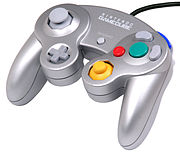 Silver Nintendo GameCube wired controller.
Silver Nintendo GameCube wired controller.
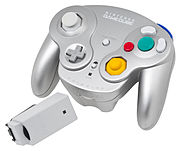 WaveBird wireless controller + receiver
WaveBird wireless controller + receiver
The Nintendo GameCube controller adopted a similar style to the PlayStation DualShock. It has two analog sticks, a small D-pad, four main digital face buttons, arranged in a unique radial pattern (A, B, X & Y), a Start/Pause button, two analog triggers (L & R), a digital shoulder button (Z) located above the R trigger, and a built in rumble motor. The triggers click when pressed down completely, allowing each button, in theory, to provide two buttons' functionality. Nintendo later introduced the WaveBird controller, a wireless pad that uses radio frequency technology refined from the Atari Wireless RF controllers, in order to operate without relying on infrared. The WaveBird overall has the same layout as the standard, but doesn't include a rumble motor (in order to save battery life) and features a larger center section than the standard GameCube controller. It operates using two AA batteries and ranges about 100 hours of gameplay.
Xbox
Similar in design to the Dreamcast controller, the Xbox controller includes two expansion slots, six analog buttons, two analog triggers, and two analog sticks, a total of eight digital buttons (four of which make up the D-pad), as well as built in rumble support. Differing from the Dreamcast controller, the Microsoft controller adds a right analog stick, making it similar to the configuration used by the Nintendo GameCube controller. It also adds the "black", "white" and "back" (select) buttons.
The Xbox controller went through a revision specifically for Japanese consumers and due to complaints that the initial controller was too bulky. (The size of the Xbox controller has been the subject of many jokes in video game-related web comics; it has even been nicknamed "Duke" and "Hamburger".) The result was the Type-S controller which Microsoft adopted and has since bundled with their system in all regions. Both of the original Xbox controllers had a breakaway point near the end of the cord, so it would break into two parts and the game would pause if it was pulled too far, preventing damage to the console itself.
Seventh Generation
Xbox 360
Main article: Xbox 360 Controller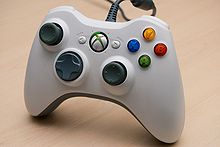 Xbox 360 wired controller.
Xbox 360 wired controller.
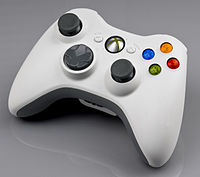 Xbox 360 wireless controller
Xbox 360 wireless controller
The Xbox 360 controller has wireless capabilities and removes the "black" and "white" buttons of its predecessor and in their place adds two "bumper" buttons, one above each trigger. When playing original Xbox games on the 360, the left and right bumpers are used in place of the white and black, respectively. The pressure-sensitivity feature on the face buttons was removed, making some original Xbox games, such as Metal Gear Solid 2, unplayable. The wireless version runs on two "AA" Batteries or a rechargeable battery pack. Microsoft has released a first-party "Play and Charge" kit which recharges the battery pack via a USB connection through the controller, though while connected the pad still communicates wirelessly. The wired version uses a USB cable to plug into the Xbox 360. The wired pad, or the wireless pad with the Xbox 360 Wireless Receiver for Windows are the standard gamepad for Games for Windows games, and can be configured to work with most PC software that supports gamepad or joystick input. Windows games that were originally developed for the Xbox 360 will normally support Force feedback with the standard Microsoft driver. For older Windows games (normally games coded to the older DirectX standard), installing the open-source XBCD driver may enable in-game Force Feedback effects.
PlayStation 3
Main articles: Sixaxis and DualShock 3Initially, the conceptual controller for the PlayStation 3 was similar to its DualShock and Dual Analog predecessors; however, it was much more curved in shape than these controllers, with an appearance similar to that of a banana or boomerang. This odd shape has often been the subject of much ridicule, often being called a banana, a boomerang, or a "bananarang".
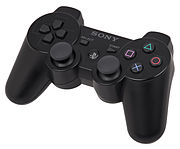 The PlayStation 3's DualShock 3 wireless controller, which includes both vibration function and the motion-sensing functionality of the original Sixaxis wireless controller.
The PlayStation 3's DualShock 3 wireless controller, which includes both vibration function and the motion-sensing functionality of the original Sixaxis wireless controller.
By the E3 2006 conference, Sony had abandoned the boomerang-shaped controller, in favor of a controller dubbed Sixaxis. The Sixaxis is cosmetically similar to the DualShock, but has several new features which distinguish it. It is a wireless controller and features the addition of tilt-sensor and linear accelerometer technology, as well as larger 'trigger-like' L2 and R2 buttons. A new "PS" button was added to expedite usage of the XrossMediaBar System, as well as four player-indicator LEDs on the rear of the controller. It is charged by way of a mini-USB port situated where the cable on its predecessors left the controller, which can also be used to allow wired play. However, the Sixaxis lacks the rumble capability featured in the preceding DualShock and DualShock 2 controllers. Sony stated that the reason for this was that the rumble would interfere with the motion sensor; however, it was later traced to Immersion Corporation suing both Sony and Microsoft for patent infringement on Immersion's haptic-feedback technology. Microsoft settled out of court, but Sony decided to fight back and lost the resultant case.
Having settled the issue with Immersion in late 2007, Sony launched the DualShock 3. The controller is the same as the Sixaxis in almost every way but differs in that the blue lettering next to the USB port has been changed to DualShock 3 (with the word Sixaxis moved below it), it contains the aforementioned vibration motors (which also give the controller more weight) and the plastic it is made from is opaque rather than slightly translucent.
Wii
Main article: Wii RemoteThe Wii Remote is an unconventional controller in comparison to others. In its basic form, it is shaped like a television remote control and includes a number of features. Most notably, it contains tilt sensors and three-dimensional pointing which allows the system to understand all directions of movement (up, down, left, right, in, and out, etc.) and rotation (back and forth around the pitch, roll, and yaw axes). The Wii Remote has four buttons, labeled A, B (on the back), 1 and 2, plus the start (+), select (-) and home button (a house). The controller is also multifunctional and expandable, including an expansion bay which can be used with different types of peripherals. An analog stick peripheral called "Nunchuk" features two trigger buttons(C and Z) to be used by the other hand. Like the Wii Remote, the Nunchuk contains an accelerometer[9] but unlike the Wii Remote, it lacks any pointer functionality. For NES Virtual Console games, the Wii Remote can be used on its side or the classic controller can be used.
The Classic Controller is also available for use with the Wii's Virtual Console as well as some Wii titles. It resembles a Super NES controller and contains two analog sticks placed similarly to Sony's DualShock. Instead of having start and select buttons, it has the -, home, and + buttons from the Wii Remote. However, there are text labels below each button, reading "Select", "Home" and "Start" respectively.[10] There are four action buttons labeled A, B, X and Y, as well as the L and R shoulder buttons, plus the ZL and ZR buttons. The console also supports use of the Nintendo GameCube controller for Nintendo GameCube Game Discs compatibility and limited Virtual Console play, as well as certain Wii games (most notably Super Smash Bros. Brawl). Also, the Wii Classic Controller Pro was released for the Wii, and shared the design of the PlayStation 2 controller.
At E3 2007 the Wii Zapper was unveiled for the first time to the public. The Wii Zapper gives players a sense that they are holding a gun, arguably making first person shooters more immersive. The attachment lists for $19.99 in the United States and simply uses the regular Wii Remote and Nunchuk to form the shape of a gun.
Eighth Generation
Wii U
Main article: Wii U ControllerWii U Controller features a 6.2 inch touchscreen which either replicates or supplements the gameplay displayed at the television screen, along with motion sensing, front-facing camera, speakers, microphone and rumble feature. In addition, the controller has two analog circle pads and one D-Pad, along with four face buttons (labeled A, B, X and Y), four shoulder buttons (labeled L, R, ZL and ZR), and "Select", "Start", "Home" and power buttons.
Other Gamepads
- Amiga CD-32
- Asus Eee Stick
- CD-i
- ColecoVision
- Gravis Gamepad
- Intellivision
- Logitech gamepad
- Microsoft SideWinder
- MS Freestyle Pro
- neGcon
- Neo Geo CD
- PC Engine
- Saitek Cyborg
See also
References
- ^ Square Button Famicom: My new paperweight
- ^ Ashcraft, Brian (2008). Arcade Mania!: The Turbo-Charged World of Japan's Game Centers. Kodansha. pp. 192. ISBN 9784770030788.
- ^ Controllers - Jaguar Controller. AtariAge. Retrieved 9 December 2008.
- ^ "Classic Game Room HD NEO-GEO CD Controller review". http://www.youtube.com/watch?v=DfEDgdwcm90&feature=related.
- ^ a b "Multi Controller (analog Pad)". segagagadomain.com. http://www.segagagadomain.com/hardware-sat/hard-analoguepad.htm. Retrieved 1 August 2010.
- ^ National Console Support, Inc. | Saturn USB Control Pad - Grey
- ^ OMG: Sega Saturn USB Controller works Flawlessly on PS3!!
- ^ Nintendo Wii ::: Advanced Media Network - Mario, Zelda, Metroid, Super Smash Bros, Wii, Revolution
- ^ Nintendo.com News : Nintendo Reveals 'Revolution'-ary Controller in Keynote Speech
Categories:- Game controllers
Wikimedia Foundation. 2010.



